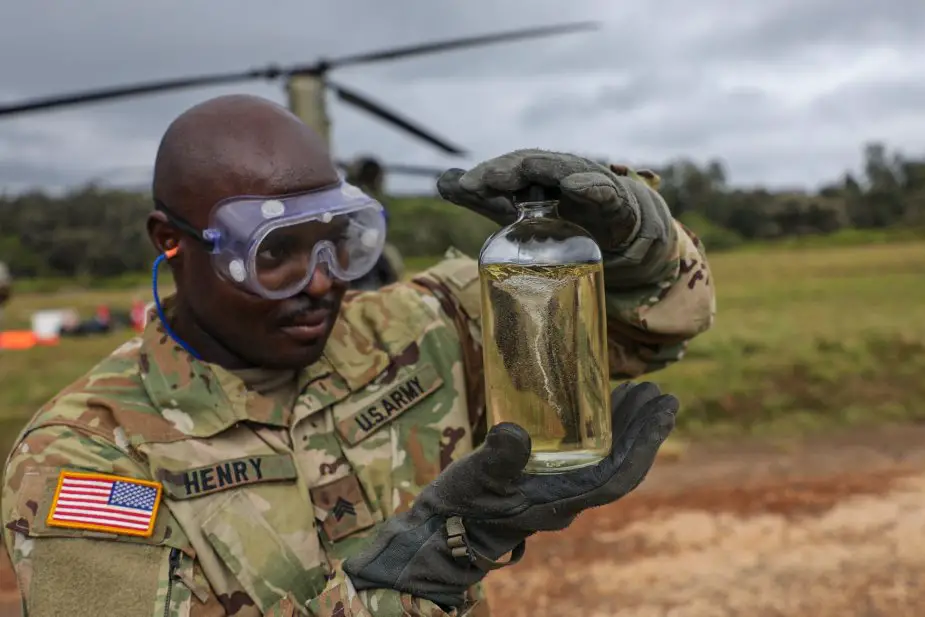First-of-its-kind U.S. Army model expands military fuel options
U.S. Army researchers developed a new, advanced scientific model that will allow vehicle maintenance specialists to turn to bio-derived fuels in austere locations. With this solution, the Army can reduce logistics costs associated with transporting and storing military fuel for military operations overseas. Instead, the Army can convert biomass, like wood logs, into usable fuel when and where it’s needed, or use any locally available fuels that have different specifications from the jet fuels in the United States.
Follow Army Recognition on Google News at this link

A model developed by Army researchers shows predictive capabilities more advanced than commonly-available applications currently used often in the military and civilian aviation (Picture source: U.S. Army/Sgt. Sarah Sangster)
U.S. Army Researchers said the model proves effective in predicting the performance of bio-derived jet fuels. The current state-of-the-art models cannot predict the performance of bio-derived jet fuels in the intermediate temperature region.
The first-of-its-kind, chemical kinetic model was developed by researchers at the U.S. Army’s Combat Capabilities Development Command’s Army Research Laboratory for a bio-derived, alcohol-to-jet fuel, said Dr. Mike Kweon, program manager of the laboratory’s Versatile Tactical Power and Propulsion Essential Research Program.
Directed evolution of enzymes, which was groundbreaking research developed by Dr. Frances Arnold, an Army-funded researcher who won the 2018 Nobel Prize in chemistry, was used to develop the bio-derived alcohol-to-jet fuel as a drop-in fuel for military jet fuel F-24, a lower-cost alternative to the standard JP-8 fuel.
This model, Kweon said, could help the Army maintain operations and more easily rely on locally-available fuels without the risk of those fuels degrading the performance of Army air and ground vehicles. This model will also allow engine developers to develop multi-fuel capable engines in the future. “Our model offers a critical step in any combustion modeling, especially for the Department of Defense considering we use jet fuels,” Kweon said. “Currently, there is no alcohol-to-jet chemistry that works in a wide range of temperature regions from high, intermediate to low-temperature regions. Although our model is not a perfect solution, it works for our application as well as anyone who wants to model ATJ combustion.”
The Army model, enabled by generic algorithm machine learning, will be used to describe the ignition of the alternative fuel when used in Army vehicles in locations where temperatures and altitudes vary widely.
A genetic algorithm in machine learning is a stochastic search algorithm to find a potential solution. It acts like inbreeding, Kweon said, where potential solutions are encoded as genes or strings of characters in computer programs that are called population. New solutions are produced by breeding the current population members.
Existing models used throughout military and commercial aviation for this type of fuel can only predict conditions relevant to civilian aviation and Air Force applications, Army researchers said.

U.S. Army researchers offer a new chemical-kinetic model to accurately describe the ignition of alternative jet fuel, like the fuel shown here, for Army relevant conditions (Picture source: U.S. Army/Sgt. Sarah Sangster)
The Army’s solution enters new space, Kweon said, because an alternative jet fuel chemistry didn’t exist before now to characterize the performance of Army vehicles whose combustion is mostly constrained in the intermediate temperature region, which is typically between 400 and 730 degrees Celcius. The immediate temperature region is a typical operating condition of piston engines with whom the majority of Army vehicles are powered, he said.
During deployments, the Army may rely on locally-available fuel for extended operations with limited-to-no resupply, but this can introduce vehicles to a mix of fuel types ranging from alcohol to diesel that, if untreated, can damage the engines.
"We needed ATJ chemistry as the most extremely ignition quality fuel to investigate the blends of F-24 and ATJ fuels for our multi-fuel applications,” Kweon said “My team had no choices other than being creative in advancing the model that works for our applications,” Kweon said the research team is focusing next on developing chemistry that works a wide range of ignition quality from ATJ to F-24, and to use the latest model to guide the development of ignition assistant technology.


























